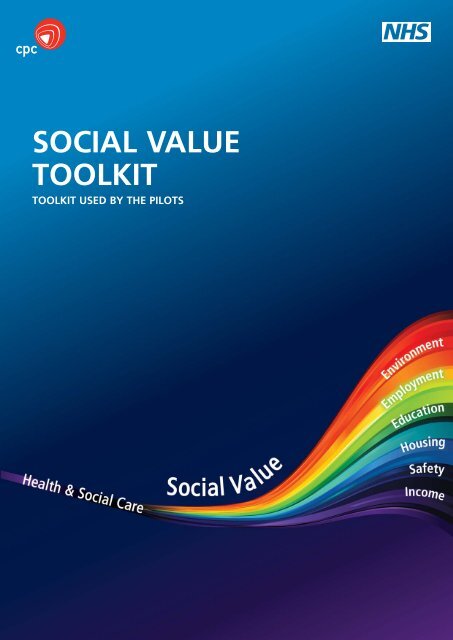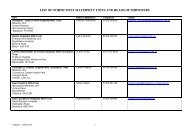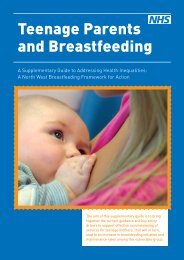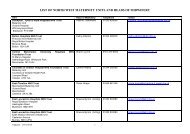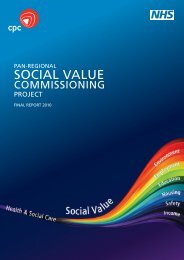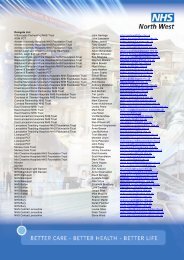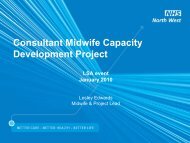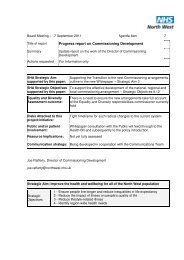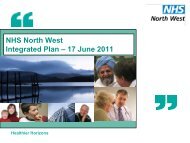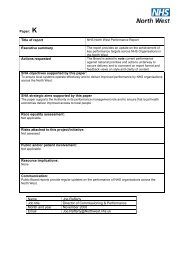Social Value Toolkit Report - Voluntary Sector North West
Social Value Toolkit Report - Voluntary Sector North West
Social Value Toolkit Report - Voluntary Sector North West
- No tags were found...
Create successful ePaper yourself
Turn your PDF publications into a flip-book with our unique Google optimized e-Paper software.
SOCIAL VALUETOOLKITTOOLKIT USED BY THE PILOTS
CONTENTS 021. INTRODUCTION 031.1 DEFINITION 031.2 PROJECT REMIT 031.3 HOW THE TOOLKIT FITS INTO THE COMMISSIONING CYCLE 041.4 PILOT SITE SUPPORT 042. SELF ASSESSMENT 042.1 INTRODUCTION 042.2 THE SELF ASSESSMENT FRAMEWORK 042.3 INSTRUCTIONS ON HOW TO USE THE EXCEL SELF ASSESSMENT TOOL 092.4 REPEATING THE SELF ASSESSMENT AND UNDERSTANDING THE PROGRESS MADE 103. PRIORITISATION AND MEASUREMENT FRAMEWORK 113.1 INTRODUCTION 113.2 FRAMEWORK 113.3 PRIORITISATION 124. DEVELOP UNDERSTANDING WITH PROVIDERS 134.1 ABSORPTION 134.2 DIFFUSION 134.3 GENERATION 134.4 EXPLOITATION 135. EVALUATION FRAMEWORK 145.1 INTRODUCTION 145.2 EVALUATION FACTORS PILOT SITE FEEDBACK AND REVISED EVALUATION FACTORS 145.3 EVALUATING COMPETING TENDERS USING THE ‘OPTIONS APPRAISAL TOOL’ 175.4 IMPORTANT DO’S AND DON’TS WHEN EVALUATING COMPETING TENDERS 206. MONITORING FRAMEWORK 21
1. INTRODUCTIONManagers and commissioners within the public sector are caught in a ‘value squeeze’ (i.e. increasingpressure to do more with less) as they seek to deliver more and better services under tighter budgetconstraints.Given these pressures and constraints it is useful to establish howsocial value can be brought to both existing service provision andalso services that are at the procurement stage. In order toachieve this commissioners need to look at the wider value thata service can bring, i.e. the primary outcome for which theservice will be commissioned or exists, plus any additionalbenefits it can have to society and the public. This toolkit is thefirst step in a move towards this and we have taken the approachthat the concept and application of social value should beadaptable to enable an organisation to capture social value fromits existing commissioning activity, but also to generate socialvalue in new commissioning activity. It is important to note at thispoint that there may be instances where it is not appropriate togenerate social value from new commissions, for example theremay be significant cost associated to the ‘added value’ or theremay be a defined process which may be complicated by this.1.1 DEFINITIONThe working definition of social value for the purposes of thisproject is: ‘social value is the additional benefit to thecommunity from a commissioning / procurement processover and above the direct purchasing of goods, servicesor outcomes’Examples of social value:• Purchase of 5,000 units of stock, with the added social valueof using a local supplier thus stimulating the local economy• A good neighbour scheme which uses volunteers. The socialvalue of this is attributed to volunteers being targeted fromspecific age groups and locations in line with other indicators,thus decreasing social isolation for the primary group ofindividuals (the purpose of the commission), but also for thevolunteers (secondary benefit)• A garden exchange scheme with the primary purpose to helpolder people live at home and reduce social isolation. Thesecondary (social) benefits of this were increasingvolunteering within the community, social engagement,physical activity, intergenerational contact, improved physicalenvironment• ALMO – sets up a tendering process for firms to undertakeconstruction work on their properties. The winning firm is agroup that offered to provide social value in the form ofpromoting careers in construction and in trades to localschools; they are also committed to employing localapprentices and working with the local neighbourhoods• A statutory provider service setting up a user-led organisationto deliver some or all of its core services. This providesprevious passive recipients of support with an active rolewhich increases their choice and control, helps developtransferable employability skills, decreases the burden onstate resources by using new ways of working to supporttheir lives and the lives of others.1.2 PROJECT REMITCPC have been commissioned by NHS <strong>North</strong> <strong>West</strong>, on behalf ofall 10 Strategic Health Authorities, to deliver a pan-regionalcommissioning project. This national project involves workingwith a number of pilot sites on the research, testing anddevelopment of a multi-dimensional framework to guide the NHSand its partners on ways of releasing maximum social and publicvalue from NHS and related investment. The aims of this projectare two-fold:1. Develop a framework within which the social value of thecurrent commissioning and procurement activity can becaptured and articulated – this will allow the NHS to show its‘true’ value across the public sector; and2. Embed the use of social value concepts in commissioning andprocurement activities – this will allow commissioners to‘manage’ social value across a whole system and to workmore effectively with their partners to deliver social valueoutcomes03
1.3 HOW THE TOOLKIT FITS INTOTHE COMMISSIONING CYCLEIn order to further develop the concept ofsocial value we have developed a toolkitwhich is designed to support commissionersto use the concept within their localityand to best affect. This toolkit is notdesigned to replace or even duplicate thework of existing processes. Rather, it hasbeen designed to sit alongside andcompliment existing processes (as can beseen to the right), and therefore remainssufficiently generic for adaptation byindividual localities and organisations.SITUATION ANALYSISPLANDOUNDERTAKE SELF ASSESSMENTDEVELOP SOCIAL VALUE PRIORITIESSELECT PILOT COMMISSIONCONSTRUCT EVALUATION FRAMEWORKDEVELOP UNDERSTANDING WITH PROVIDERSEVALUATE TENDERS/OPTIONSDEVELOPING MONITORING FRAMEWORK1.4 PILOT SITE SUPPORTREVIEWAs part of the overall programme CPC areable to offer each of the eight pilot sitesapproximately 1.5 days of support eachduring Phase 2 up to the end of February2010 to help develop and embed this within the pilot organisation.CPC will then record the outcomes, findings and case studiesof good practice from the pilot sites and report back to theProject Board, which is made up of representatives of theStrategic Health Authorities.REPEAT SELF ASSESSMENTKNOWLEDGE2. SELF ASSESSMENT2.1 INTRODUCTIONThe diagram on the right demonstrates how this pilot is designedto support organisations to both increase their knowledge ofsocial value, but also to use the concept (engagement) to releaseadditional value from commissioning and procurement.The purpose of Self Assessment is to understand at an individual,group and an organisational level where you are on this knowledgeengagement curve; it is also a useful tool to use to raise awarenessof social value with other colleagues and partners.An objective of this project and the tools created is to enablepeople and organisations to move around the knowledge /engagement curve. Initially, all of the pilot sites undertook anassessment of where they are on the knowledge / engagementcurve as individuals. This baseline may assist in ascertaining whatactions need to be taken to embed the concept within theorganisation and a repeated assessment at the end of the pilotwill provide evidence how fast and far people can move along thecurve given the appropriate assistance development opportunities.The definitions of the knowledge and engagement measureshave largely been based on the World Class Commissioning(WCC) competencies and adapted for social value. Part of thepilot will be to test what are the significant drivers to enablemovement around the knowledge and engagement curve. Thiswill also help to inform a wider rollout of the social valueprogramme in the future. Details of the competencies and howthey relate to the WCC competencies are given in the table overleaf.ENGAGEMENT2.2 THE SELF ASSESSMENT FRAMEWORKEach indicator is assessed against a four point scale: level one,level two, level three, level four (where one is the first level andfour is world class). Each of the levels for the competencies ismeasured on an additive basis. The organisation or individual willtherefore have to meet the criteria at level one to progress to leveltwo, and will have met the criteria for levels one and two toprogress to level three.This assessment can be undertaken or considered at differentlevels: an organisation, a team or service within the organisation,as individuals within the organisation/team; or as a partnership.Therefore, the word ‘organisation’ can be replaced with ‘team’. It isalso important to note that where the term ‘non-health based’ isused this refers to objectives outside of the remit of an NHSorganisation.
Knowledge –Organisation’sunderstanding ofthe key drivers ofnon-health basedobjectivesKnowledge –Organisation’sunderstandingof any gapstowards achievingnon-healthbased objectivesSOURCE: WCCCOMPETENCYAnalytical skills andinsightsUnderstanding ofhealth needs trendsLEVEL 1 LEVEL 2 LEVEL 3 LEVEL 4• Does notmeet Level 2requirements• Does notmeet Level 2requirements• A consistentmethodology isused to identifygaps in deliveryof non-healthbased objectivesand drivers ofperformance inaddressing thesegaps• The organisationcan identify overtime trends inmajor non-healthbased issues• The organisationanalyses progresstowards a range ofnon-health basedobjectives andidentifies keycauses of variancefrom expectations• The organisationanalyses progressand identifies anygaps towardsachievingnon-health basedobjectives• The organisationanalyses progressand any gaps,identifies the keydrivers of variancefrom expectationsand developssolutions• The organisationsand partners useof predictivemodelling andanalytical toolsacross partnershipsto discuss anddescribe trends inneeds, createfuture projects andidentify variationfrom expectationsKnowledge –Organisation hasdeveloped plansto improve itsnon-healthbased objectives(includingmeasurementof)Use of health needsbenchmarks• Does notmeet Level 2requirements• The organisationhas developedplans to improveits performance oneach benchmark• The organisationhas developedplans to improveits performance tomeet stretchoutcomeaspirations andbenchmarks onother non-healthbased objectives• The organisationand partners havedeveloped plansto match the topperformers oneach benchmarkand identifies thekey capabilities itwill need to developto match theirperformanceKnowledge –The extent towhich theorganisationcan identify thenon-health basedfactors thatproviderscould deliverKnowledge of currentand future providercapacity and capability• Does notmeet Level 2requirements• The organisationworks with theLocal Authority,other local PCTsand commissionersto perform arobust marketanalysis on allsegments of themarket for alldeterminants ofhealth• The organisationworks with theLocal Authority,other local PCTsand commissionersto prioritise marketsegments fortargetedimprovementaction, identifypotential costs andbenefits of changingor managingproviders inpriority segmentsfor all determinantsof health• The organisationhas dedicatedresource and thenecessary strategicpartnerships withthe right expertiseand experience tosupport:o Robust marketanalysiso Marketmanagemento Provider capabilitydevelopmentfor alldeterminants ofhealth05
Knowledge –The extent to whichthe organisationcan measure thenon-health basedfactors of providersSOURCE: WCCCOMPETENCYCollection ofquality andoutcome informationLEVEL 1 LEVEL 2 LEVEL 3 LEVEL 4• Does notmeet Level 2requirements• There is clearidentification ofsocial valuemetrics to monitor(both nationalcontract andlocally agreed)• The metricschosen are agreedwith the relevantstakeholders• Informationprovides sufficientdetail to supportidentificationof drivers ofperformance andquality for socialvalue measures• The organisationhas developedstrategies formonitoring theimpacts of specificinitiatives onsocial valuemeasuresKnowledge –The extent to whichthe providers aremeasured andwhether thisinformation isdiscussed withprovidersUse of performanceinformation• Does notmeet Level 2requirements• Data on socialvalue measuresis collected andanalysed atmonthly (orappropriate)intervals• Data on socialvalue measures isanalysed in nearreal time and isregularly discussedwith providers• The organisationcan demonstratedata on socialvalue measuresis proactivelydiscussed withproviders todrive fact-basedcontinuousimprovementKnowledge –The extent to whichthe organisation hasidentified gaps inthe providers’provision whichcould assist insocial valueAlignment of providercapacity with healthneeds projection• Does notmeet Level 2requirements• The organisationhas identified gapsin market supplyand for risks insupply structureand has mitigationplans• The organisationis forecastingpotential as wellas current risksand has adequatemitigation plans,particularly wherethe impact isbroader than theorganisation• The organisationimplementsspecific changesto providercapacity drivenby provider marketanalysis, needsmodelling,includinglong-termstructural changes,and forecastsbased on actualrisk analysisKnowledge –The extent to whichthe organisationunderstands theprovider cost impactof requesting socialvalue outputUnderstanding ofprovider economics• Does notmeet Level 2requirements• The organisationrecognises thatthere is a costto gatheringinformation onsocial value butis not able toquantify them• The organisationunderstands theeconomic impactof including socialvalue measures• The organisationallows for theeconomic impactsof including socialvalue measureswithin itscontracts
Engagement –Level ofparticipation oforganisation againstthe non-healthbased agendasSOURCE: WCCCOMPETENCYn/a • Does notmeet Level 2requirementsLEVEL 1 LEVEL 2 LEVEL 3 LEVEL 4• The organisationparticipates indelivery of theagendas of someother public sectorpartners• The organisationcan articulate itscontribution to thedelivery ofnon-health basedagendas• The organisationactively participatesin deliveryof the agendas ofsome other publicsector partners• The organisationcan demonstratethe deliveryagainst thesenon-health basedagendas• The organisationactively participatesand makes asignificantcontribution to thedelivery of othernon-health basedagendasEngagement –Level to whichthe organisationis engaged indelivery ofnon-healthbased LAAtargetsCreation of LAA basedon joint priorities• Does notmeet Level 2requirements• The PCT and thelocal authority areboth jointlyaccountable forLAA targets• The role of theorganisation in theLAA and deliveryof targets is effective• The organisationhas clear evidencethat it is activelyengaged in theongoing monitoring,delivery andperformancemanagement ofnon-health basedLAA targets• The organisationactively engageswith partners toassist with thedelivery ofnon-health basedLAA targets• There is clearorganisationalleadership inthe delivery ofnon-health basedLAA targetsEngagement –Extent to whichlocal stakeholdersbelieve theorganisationdelivers onnon-healthbased targetsReputation as anactive and effectivepartner• Does notmeet Level 2requirements• There isevidence that keystakeholderssomewhatagree that theorganisation is aneffective partnerin deliveringnon-health basedobjectives• There isevidence thatkey stakeholdersagree that theorganisation is aneffective partnerin deliveringnon-healthbased objectives• There is clearevidence thatkey stakeholdersstrongly agree thatthe organisationis an effectiveand lead partnerin deliveringnon-health basedobjectives07
Engagement –The degree to whichthe organisation hasdefined criteriafor prioritisinginvestment toinclude non-healthbased objectivesSOURCE: WCCCOMPETENCYPrioritisation ofinvestment anddisinvestment toimprove population’shealthLEVEL 1 LEVEL 2 LEVEL 3 LEVEL 4• Does notmeet Level 2requirements• The organisationhas defined criteriafor evaluatingand prioritisinginvestment anddisinvestmentincluding impacton non-healthbased objectives• Investment anddisinvestmentproposals containpredictedimprovement innon-health basedobjectives andLAA targets• The organisationhas a robustprocess for usingits criteria toevaluate andprioritiseinvestment anddisinvestment inkey public healthobjectives anddelivery of localnon-health basedobjectives• The organisationunderstands thereturn on pastinvestment anddisinvestmentaimed atnon-health basedobjectives andcompares this tobest practice. Thisis used to informfuture investmentand disinvestmentEngagement –The extent to whichidentified gaps areaddressed withininvestment plans fornon-health basedobjectivesIncorporation ofpriorities into strategicinvestment plan toreflect differentfunding scenarios• Does notmeet Level 2requirements• There is somealignmentbetween identifiedgaps, currentinitiatives toaddress thosegaps, and strategicinvestment plan• Prioritisationincludes locallyagreed non-healthbased objectives• There is clearand consistentalignmentbetween identifiedgaps, currentinitiatives toaddress thosegaps and strategicinvestment plansfor non-healthbased objectives• Projects andinitiatives areevaluated againstprioritisation witheffective targetingof resourcestowards projectsthat delivergreatest outcomegainsEngagement –The extent to whichthe organisationuses social value inits negotiationsNegotiation ofcontracts arounddefined variables• Does notmeet Level 2requirements• There is clearidentification oflocally definednegotiationvariables andservice targetsincluding socialvalue measures• The organisationexplicitly usessocial valuemeasures as partof its negotiations• Negotiation hassuccessfullydelivered changesto social valuevariables insignificantimprovements inthe delivery ofsocial valueoutputsEngagement –The extent to whichstaff are confidentin the use of socialvaluen/a • Does notmeet Level 2requirements• Staff have anunderstanding ofsocial valueconcepts andmeasures• Staff are confidentin the use ofsocial value andregularlyincorporate itsuse intocommissioningactivity• Staff can fullyarticulate socialvalue, their impacton the delivery oflocally agreedobjectives andregularly discussways to improve
2.3 INSTRUCTIONS ON HOW TO USE THE EXCEL SELF ASSESSMENT TOOLEXCEL TOOL: Self Assessment ToolPassword (for editing purposes): CPCNote: In order to avoid write-over errors, most calculation cellsare by default 'locked'. To unlock all cells within, and thestructure of a given sheet then select Tools / Unprotect Sheet andenter the password CPC (case sensitive).When filling in the self-assessment, you should try to provide orthink of up to three supporting points or examples which youhave taken into account when assessing yourselves. This way,progress can be measured over time and assessments can undergointernal quality assurance processes. In order to undertake theself assessment we have created a simple excel based tool.The Self Assessment Tool has been grouped into the followingcolour coded tabs for ease of use:• The sheets with blue tabs relate to the self assessment toolo ‘Assessment 1’ – this is a blank sheet for data inputo ‘Assessment 1 Scatter’ – this will display the results of thedata from the assessmento ‘Assessment 2’ – a blank sheet for further assessmentso ‘Assessment 2 Scatter’ – this will display the results of thedata from the assessmento ‘Time Series Scatter’ – this will map the results of thebaseline assessment (entitled workshop), which was takenat the initial presentations, along with the results ofAssessments 1 and 2• The sheets with orange tabs relate to results of the selfassessment in workshop, this is defined as the baselineo ‘Baseline Assessment’ – this sheet displays the results thatwere taken from the presentation sessionso ‘Baseline Scatter’ – this sheet displays the results in theform of the knowledge and engagement table• The sheets with green tabs relate to comparison with otherlocalitieso ‘Comparison Scatter’ – displays your results against theother 7 pilot sites in the form of the knowledge andengagement curve• Reference Sheetso The Definition of Factors sheet is the document that shouldbe printed for individuals to complete the assessmentSELF ASSESSMENT EXERCISE:This assessment can be undertaken or considered at four levels:an organisation, a team or service within the organisation, asindividuals within the organisation/team; or as a partnership.STEP 1: The individual, team, organisation or partnership shouldcomplete the assessment using the printed sheet which can befound on ‘The Definition of Factors’ sheet at the end of the tabsin the tool.STEP 2: Each indicator is assessed against a four point scale: levelone, level two, level three, level four (where one is the first leveland four is world class). Each of the levels for the competenciesis measured on an additive basis. The organisation or individualwill therefore have to meet all of the criteria at level one toprogress to level two, and will have met the criteria for levels oneand two to progress to level three. The person completing theassessment should circle the description that best describes youand your use of social value. When filling in the self-assessment,you should try to provide or think of up to three supportingpoints or examples which you have taken into account whenassessing yourselves. This way, progress can be measured overtime and assessments can undergo internal quality assuranceprocesses.STEP 3: Once this paper based copy of the assessment has beencompleted the results should be input into the ‘Assessment 1’ or‘Assessment 2’ blue tabs in the tool, as seen below. This can bedone on an individual basis, group or time basis by changing thefield in the ‘Upon what is the comparison’ which can be found atthe top left of the sheet. Changing this comparison will not affectany of the functions or results it will simply change the topheading of the column from Individual 1 to Group 1 or Time 1.This allows you to input the results as groups or over time. Forexample, if the results are measured over time then Time 1 maybe a group or individual’s result at a baseline and then thesubsequent Time 2, 3, 4...... will represent repeat assessmentsover time by that group or individual.UNDERTAKING THEIndividual 1 Individual 2 Individual 3 Individual 4 Individual 5 Individual 6 Individual 7Level of participation of organisation against 3 3 3 4 3 3 2the non-health based agendasLevel to which the organisation is engaged 2 3 3 3 2 2 2in delivery of non-health based LAA targetsExtent to which local stakeholders believe the 2 2 2 3 3 1 2organisation delivers on non-health based targetsThe degree to which the organisation has defined 3 2 2 3 2 1 1criteria for prioritising investment and disinvestmentto include non-health based objectives09
STEP 4: Once this data has been input, it will automaticallyupdate the two tables, the ‘Assessment 1 (or 2)’ chart and the‘Time Series Scatter’. The table on the right is the scatter graphfor the assessment which will visually demonstrate how a rangeof individuals have scored on the knowledge and engagementcurve. The second table ‘Time Series Scatter’ will demonstrateprogress over time, compared to the baseline and previousassessments undertaken.KNOWLEDGEENGAGEMENT2.4 REPEATING THE SELF ASSESSMENT AND UNDERSTANDING THE PROGRESS MADEIn order to understand how far an individual, team, organisation orpartnership has progressed it is important to undertake thisassessment post pilot and periodically thereafter. Below are somekey questions to consider when repeating this process:• How far have the individuals moved around the curve?• How far did the organisations move around the curve?• What best facilitated the transition around the curve?• How difficult did the participants feel the journey was?• Is it best to educate the wider organisation, via social valuemasters or working with the wide group?• How quickly can you move around the curve as an individualand an organisation?• Are issues/blockages related to a lack of knowledge or a lackof engagement/participation?KNOWLEDGETowards the end of the project, we will request that you updateyour self assessment to note progress made and what facilitatedthis progress. In order to capture this progress and ensureconsistency across each of the 8 pilot sites we will be in contactwith yourselves to undertake this repeat assessment.ENGAGEMENT
3. PRIORITISATION AND MEASUREMENT FRAMEWORK3.1 INTRODUCTIONAny system for measuring social,environmental and economic value willneed to be based on recognition thatthe results are relative and arisefrom negotiation between different stakeholders.This means that the key is to havea process or framework which is shared byusers.Measures of social value will be different indifferent markets and for differentpeople. However some commonality ofindicators within similar markets will alsofacilitate the ability to trade on social andenvironmental value.COMPREHENSIVEAREAASSESSMENTEVERY CHILD MATTERS OUTCOMESLOCAL AREAAGREEMENTWORLD CLASS COMMISSIONINGPRIORITIES/(SUB-)REGIONALHEALTH PRIORITIESINCOME EMPLOYMENT HEALTH EDUCATION HOUSING ENVIRONMENT CRIMENATIONAL INDICATOR SET & VITAL SIGNSLOCAL INDICATOR SET/MEASURESNATIONALPOLICY AGENDATOTALPLACEADULT SOCIAL CARE OUTCOMES3.2 FRAMEWORKIn order to obtain a pragmatic approach toboth the prioritisation and measurementof social value across a range of partners wehave developed the framework on the right.WORD TOOL: <strong>Social</strong> <strong>Value</strong> Measurement FrameworkThe framework is a generic approach and may be tailored toa locality to include the driving force(s) for public sectorcommissioning within your area, for example the sustainablecommunity strategy. The use of seven domains, as shown above,facilitates discussion around the generation of social value thatwill support other partners agenda’s whilst also having an effecton the wider determinants of health (Dahlgren and Whitehead).In essence the framework can be seen as displaying the drivingforces for commissioning activity (in red), and the potential forsocial value (in blue). This framework also provides a consistentapproach to measuring value across organisations.A large proportion of work that the NHS undertakes can have awider social value, both within the specific locality, and a muchwider community, as can be seen in the work of Anna Coote’sand the Health Dividend 1 . For example, a commissioned piece ofwork could contribute to local employment through targetinglocal residents for delivery, LAA targets such as volunteering.Practical examples of this can be found in areas such as,Community Health Trainers, where public health practitioners areworking towards targeting health inequalities through grass-rootshealth promotion. Other social gains from this piece of workinclude an increased number of volunteers, increased socialcapital, better social engagement and increased activity levels.The figure here demonstrates how the use of this framework canassist when seeking to obtain additional social value.Commissioning activity X has the primary purpose of tacklingobesity in school children through school based information roadshows and is informed by population need and also VSB09.Y represents additional social value as a by-product ofcommissioning activity X. This social value helps to contribute toa partner’s agenda alongside supporting the wider determinantsof health, which ultimately contribute to the risk factors thataffect health. For example, the staff may introduce volunteerprojects for local residents of the school, assisting them withhousehold chores(goodPOPULATION NEEDneighbourtasks) thuspromotingsocial cohesionand physicalactivity. Onesuch examplemay begrowing fruitin the schoolor neighboursgardens toshare amongsteveryone,whilst alsospreadinghealthy eatingmessages.1Visit: http://www.kingsfund.org.uk/document.rm?id=5211
Z is additional benefit to the community,this maybe independent to the purpose ofcommissioning activity X. For example, thesocial value generated may be the use of alocal organisation to deliver the activity.This could help to contribute towardspartner agendas through the proposedframework.Understanding and addressing social valuein this way not only enables the identificationof social value and how it will help tocontribute to partner agendas, but it alsohelps to facilitate the move towards CAAand the Government’s Total Placeprogramme which focus funding on placesnot organisations.COMMISSIONINGACTIVITYCommissioning for anorganisation to provide anddeliver audiology equipment toG.P. practices and hospitalsBACKGROUNDLittle competition within themarket and the contract tendsto be awarded to large nationalcompanies who are competitiveon price.THEMATIC SOCIALVALUE EXAMPLES1. Income - none2. Employment - % of staffemployed who live in thearea3. Health - provider couldoffer work based healthpromotion to staff4. Education - provider couldtrain staff in vehicle safetyand advanceddriving to promote saferroads5. Housing - none6. Environment - providercould offer vehicles thatuse bio diesel7. Crime - noneThe table here gives some furtherexamples of social value.Commissioning for low-levelgardening support forvulnerable adultsIssues around healthinequalities and obesitywithin the area1. Income - none2. Employment - use ofvolunteers frommarginalised groups3. Health - increasedphysical activity levels andhealthy eating messages4. Education - none5. Housing - support tomaintain properties andgeneral housing stock6. Environment -production of freshvegetables in gardensmaintained7. Crime - reduction of socialisolation and increasedcommunity cohesion3.3 PRIORITISATIONTo maximise the benefit generated it is important that the factorsprioritised in existing local strategic papers and nationalguidelines are at the core of identifying the type of social value anylocal organisation would like to generate in its procurement. Atthis stage of the commissioning cycle it is important that thecommissioners can clearly articulate these priorities. Prioritiesshould be sourced from amongst other places the Local AreaAgreement and the national policy agenda. It is also important totake account of local needs assessments and public consultation.This will also have the benefit that they will typically be identifiedwith performance statistics from the national indicator set. Usingexisting priorities and indicators will ensure that commissionerswill have a common understanding and that the concept of socialvalue fits into the wider public services agenda.To know which outcomes should be measured and incentivised,commissioners require robust information about the needs ofservice users and communities. Furthermore, service users andcommunities should be actively involved in service design and,where possible, service delivery. The involvement of serviceusers and communities in this way, sometimes referred to as‘co-production’, ensures services are more responsive to needsand create better outcomes.
4. DEVELOP UNDERSTANDING WITH PROVIDERSTo obtain additional social value from commissioning activity there is a need to develop understandingwith providers, not only of the concepts, potential risks and benefits, but also on the priorities. Tohave maximum benefit to society any additional benefit must be based on need rather thanconvenience or historical provision. This approach to developing understanding with providers issimilar to the market management and procurement information events that many organisations undertake.In order to communicate the key messages to an organisation it isimportant to understand the how an organisation learns. Wehave used the 4 competency model to identify the type ofeducation and support required. This is a model, but it is worthidentifying where each key provider is and therefore changingyour messages to them according. This model makes the assumptionthat staff from the commissioning organisation understand thesocial value concept in their area and how it will be applied. Thisis important as the messages and understanding needs to beconsistent before they get the market excited about the concept.KNOWLEDGE0123DIFFUSIONABSORPTION4EXPLOITATIONGENERATIONENGAGEMENTFor example, it depends on the provider (third sectorvs. private)• Host scenario workshops• Host external professional networks4.2 DIFFUSIONDiffusion of knowledge within provider (and betweenproviders).The purpose is to reinforce the concept with the key decisionmakers within providers and ensure the concept is embeddedthroughout the organisations. Particular approaches to deliveringthis would be:• Develop and circulate:- Guidelines / manuals to work within- Best practice study / case studies• Assist assessment of peer understanding• Develop informal networks within and between providers4.3 GENERATIONGeneration of knowledge from outsideThe purpose of this phase is to stimulate enthusiasm and ideaswithin the providers so that they can begin to think about howtheir service provision may have wider benefits to the community.Particular approaches to delivering this would be:• Provide guidelines to assist stimulation of ideas• Provide outline of framework to test ideas• Encourage Self Assessment of Providers4.1 ABSORPTIONAbsorption of knowledge from commissionersThe purpose is to educate the key decision makers in thepotential providers on the concept of social value. This will enablethe providers to ask questions and overcome any initial concerns,which is of particular importance as the commissioningorganisation will need to be aware of provider environment andensure that the concept does not stifle the market. In the thirdsector this may be re-articulation of what and how theycurrently provide services. Particular approaches to delivering thiscould be:• Provider conceptual education - need to tailor social valuemessages to audience, this will assist in tackling key drivers.4.4 EXPLOITATIONExploitation of knowledge in offeringsThe purpose of this final phase is to ensure the concept is used tobest affect within the providers and may be characterised asembedded into the provider market to the extent that providersare actively generating and capturing social value. Particularapproaches to delivering this would be:• Providing environment for providers to test ideas13
5. EVALUATION FRAMEWORK5.1 INTRODUCTIONIn the context of this social value pilot it isrecognised that there will be a primarypurpose for which a service or objects arebeing purchased, and therefore corerequirements. These core elements will bereflected in both the specifications and inthe conditions of the contract and as suchwill be assessed on the basis of these usingexisting processes and procedures. It isimportant to construct a frameworkaround which the worth of social value ofone proposal can be compared to another.<strong>Social</strong> value needs to be part of normalevaluation process, bringing the parallel setof processes into one, as can be seen here.Services / GoodsExisting evaluation of quality,quantity, cost, timeliness etcImpact of <strong>Social</strong><strong>Value</strong>Impact 1Likelihood 7Impact 2Likelihood 6<strong>Social</strong> <strong>Value</strong>Impact of <strong>Social</strong> <strong>Value</strong>Impact 3Likelihood 5Impact 4543210Likelihood 4Likelihood of achievingLikelihood ofachievingImpact 5Likelihood 3Impact 6Likelihood 2Impact 7Likelihood 1Review of core offering alongside potential social valueProcurement Decision5.2 EVALUATION FACTORS PILOT SITE FEEDBACKAND REVISED EVALUATION FACTORSWe have proposed that social value be measured on the impactof the social value and the likelihood of delivering on thepromise of social value. The previous diagram shows a high valuebut risky project in terms of social value. The use of such aframework helps the commissioning process to be more robustand transparent. However, it cannot entirely move away fromsubjective and value based judgement, but it does supportconsistency across staff and assessments.During the Phase 1 presentation to the pilot sites we askedparticipants to review the proposed ‘impact’ and ‘likelihood’factors, and provide us with any comments, observations orsuggestions. The tables overleaf highlight the overall results ofthe scoring from the pilot sites. Feedback from the sessions withregards to the factors was that people did not fully understandthe factors in the evaluation framework, and therefore the scoresand importance may reflect some of these misunderstandings.We have revised and expanded these factors and these revisionscan now be seen in the final column of the tables. By combiningthe “impact” scores with the “likelihood” scores across a rangeof competing tenders offering social value the organisation willhave the ability to assess which option is the preferred one withregards to social value. The revised factors in the tables aresuggested indicators for assessment of competing tenders,however, we recognise that there may be indicators or factorswhich are specific to your area and commissioning / procurementframework. Therefore, the factors listed should be treated assuggestions.
IMPACT OF THE SOCIAL VALUE GENERATED WITHIN THE AREAORIGINAL FACTOR AVERAGE MIN MAX NO. OF TOP 3 REVISED, CLARIFIEDSCORE APPEARANCES OR SUGGESTED ADDITIONACROSS PILOT SITESIs the social value factor deliveredagainst defined priorities? 19 13 25 5Will it enable expenditure cuts elsewhere? 12 7 18 2Is it an unique social value offering that 12 5 16 3could not easily provided by other schemes?Will it have adverse impacts? 11 9 14 1Impact – how much of the social value factor? 11 4 18 3Does it adhere to our policies and procedures? 10 7 16 2Would this initiative attract funding 10 5 13 0from elsewhere?Does it enable capacity building in providers? 9 7 11 0Is the issue (around which social value is 7 3 10 0being provided) being dealt with elsewhere?Additional factors suggested by pilot sitesIs the social value factor deliveredagainst defined priorities(including performance measures andcommunity developed priorities)?Will it enable savings elsewherewithin the organisation or for anotherpartner?Is it a unique social value offeringthat could not easily provided byother schemes?Will it have minimal or no adverseimpacts?How much of the social value factorwill be generated (e.g. 5 local peopleemployed)?Does it adhere to our policies andprocedures?Would this initiative attract fundingfrom elsewhere?Does it enable capacity building inproviders, for example personaldevelopment for staff or the releaseof social innovation?Is the issue (around which socialvalue is being offered as a solution)being dealt with elsewhere?Does the social value proposedadhere to the organisations strategicvision and/or community strategy?Relevance of the social value impactto health?15
LIKELIHOOD OF ACHIEVING THE SOCIAL VALUE OFFEREDORIGINAL FACTOR AVERAGE MIN MAX NO. OF TOP 3 REVISED, CLARIFIEDSCORE APPEARANCES OR SUGGESTED ADDITIONACROSS PILOT SITESWill it have an adverse impact on their ability to 19 12 27 3deliver the primary purpose of this procurement?Will it have an adverse impact ontheir ability to deliver the primarypurpose of this procurement?Measurability of the outcomes? 18 11 21 4Strength of evidence base 16 13 18 4Do they have the specialist experience / 15 9 19 4skills required to deliver this additionalsocial value?Is it reliant on service users / 9 8 12 0customers buying into the service?Is it reliant on the other schemes / resources / 9 5 14 0funds / grants to deliver the social value?Scalability 7 2 12 0Is it reliant on the skills sets of people 7 4 13 0they need to recruit?Are the outcomes measurable?Strength of evidence base (it isimportant to note that trulyinnovative service offerings maynot have an evidence base)Do they have the specialistexperience / skills required to deliverthis additional social value?Is it reliant on service users /customers participating in the service?Is it reliant on any other schemes /resources / funds / grants to deliverthe social value?Scalability – how well a solution(the social value) to a given issue willwork if the size of the issue ordemand increases (e.g. 5 local peopleemployed when 10,000 additionalpeople are unemployed)?Is it reliant on the skills sets ofpeople they need to recruit?Additional factors suggested by pilot sitesWill it have a positive effect instimulating innovation in the marketplace for health and social care?Is it reliant on new technologiesand if so do they exist and are theyreadily available?
5.3 EVALUATING COMPETING TENDERS USING THE ‘OPTIONS APPRAISAL TOOL’EXCEL TOOL: Options Evaluation ToolPassword (for editing purposes): CPCYou may need to enable the macros for the content towork. Guidance on how to do this is contained in MicrosoftExcel Help.STEP 1: When you open the tool you will be presented with amenu screen. Enter the commissioning / procurement activity forwhich you wish to evaluate the potential / likely social value andsave the file with appropriate name using the standard excelmenu. You will need to create and save a new file for eachcommissioning / procurement activity being evaluated.STEP 2: It is worth checking the Factors prior to undertaking thesocial value evaluation. Click on the button “Factor Adjustments”to do so.STEP 3: This will take you through to the following page. Selectthe five most important factors for both the Impact and theLikelihood, and then score each factor out of 10 for relativeimportance.STEP 4: Once complete press “Save” button below theImportance scores. If you have altered the scores and want torevert to the previous scores press “Reset”. Pressing the “Reset –equal” button will set the Importance to 1 each.STEP 5: If you wish to return to the main menu click on the“Front” button. If you wish to see more detail about the factors,or indeed you wish to change these factors then press the “FullDefinition of Impact” or “Full Definition of Likelihood”. The FullDefinition of Impact is shown below. Once reviewed andupdated click on “Return”.17
STEP 6: From the front sheet, enter the commissioning /procurement activity which you are currently planning toundertake in the Good / Service box.STEP 7: Then click on the “1 Input SV Information regardingoptions”. This allows you to enter, edit or delete the social valueaspects of different proposals.STEP 8: If you wish to enter a newcommissioning / procurement activity thenclick into the New Procurement Option cell(the white box) type in the name of theoption supplier, press return and then click“Enter Data”.STEP 9: You will be asked for a social valuefactor (as indicated here) – this is essentiallythe type of social value the procurement willprovide, for instance employment, training,reduction in crime etc. Enter a name into thedialogue box and press “OK”.STEP 10: You can now score this option /social value factor against the criteria set inthe ‘Impact’ and ‘Likelihood’ assessments. Toscore simply click on the score that best fitseach criteria. Once you have selected thescore for that individual line the box will turnwhite. Once complete press “Save”.
STEP 11: Many options will have more than one social valueaspect related to them. If this is the case select another valuefrom the drop down under the save button. The tool allows atotal of six social value aspects.STEP 12: As you navigate off this sheet it will ask if you wish tosave any changes. Click “OK” to save any changes that you havemade. (This does not save the file, but only saves the data input.When you close the excel file, you will need to save again). Fromhere you can proceed to step 14 and edit or create a newprocurement option, or you can click “2 Individual Offering” asper Step 14.STEP 13: If you wish to Edit or Delete an existing commissioning/ procurement option then select from the appropriate dropdown and click the button to the right of the drop down (as canbe seen on the right). Repeat steps 9-12.STEP 14: To view the output of a givenProcurement Option click on“2 Individual Offering”. This gives youa radar diagram of the scores for eachsocial value aspect against each of thecriteria you have set. It also maps outthe overall Impact and Likelihoodposition of each of the social valueaspects (shown on the right hand sideof the diagram).STEP 15: To view competing commissioning / procurement Optionsclick on “3 Comparison of Offering”. This scatters each of thesocial value aspects for each of the Procurement options.NOTE: evaluation of social value assumes that the providersequally offer value for money and quality provision with regardsto the primary purpose for the commission.19
5.4 IMPORTANT DO’S AND DON’TS WHENEVALUATING COMPETING TENDERSDo make sure:• CPC would advise that all policies, procedures and legislation,both locally and nationally, with regards to procurement andcontracting are adhered to.• Actions to take account of social issues are consistent withthe government’s value-for-money policy, taking account ofwhole-life costs.• Any social benefits sought are quantified and weighedagainst any additional costs and potential burdens onsuppliers or the organisation.• Not to impose any unnecessary burdens that would seriouslydeter suppliers, especially small and medium sized enterprises(SMEs), from competing for contracts, which in turn wouldreduce the choice available and could impact on costs andservice standards. The suppliers deterred could includethe very ones whose participation would help to generatesocial value.Do not:• Add social value elements to a contract without carefulevaluation and justification of any additional costs.• Leave consideration of social issues until too late in theprocess.For more information and guidance on procurement please referto the following:• <strong>Social</strong> Issues in Purchasing -http://www.ogc.gov.uk/documents/<strong>Social</strong>_Issues_in_Purchasing.pdf• Introduction to Public Procurement -http://www.ogc.gov.uk/documents/Introduction_to_Public_Procurement.pdf• Finding and Procuring Innovative Solutions -http://www.ogc.gov.uk/documents/Finding_and_Procuring_Innovative_Solutions_(3).pdfThe toolkit, evaluation report, easy read guides and furtherinformation regarding the project can be found at:http://www.northwest.nhs.uk/whatwedo/socialvalueproject/social_value_project.htmlFor further information please contact:Julie Cheetham, <strong>Social</strong> <strong>Value</strong> Project Director,NHS <strong>North</strong> <strong>West</strong>mail to: julie.cheetham@northwest.nhs.uk, 0161 625 7202Brett Nelson, Associate Director (Project Manager), CPC Ltd.mail to: brett.nelson@cpcltd.com, 07827 804156
6. MONITORING FRAMEWORKIt is important that social value is monitored just as in the service / good. You can include someelements of the social value into your contract e.g. employment of local residents, others will notbe so easily done – e.g. reducing crime.OUTPUT/OUTCOMEELEMENTS TO MONITORSERVICES/GOODSQUALITY, QUANTITY, COST, TIMELESS MEASURED AGAINST CONTRACTSSOCIAL VALUEELEMENTS WITHIN CONTRACTSELEMENTS OUTSIDE CONTRACTS• ELEMENTS THAT ARE WITHIN THE PROVIDERSCONTROL - E.G. LOCAL SOURCING OF PRODUCE• ASSOCIATED WITH A LEVEL OF CERTAINTY• NEED TO BE INCLUDED IN THE CONTRACT ANDMONITORED AT REGULAR INTERVALS IN SAMEWAY AS EXISTING CONTRACT• WHAT ARE ACCEPTABLE KPI VARIANCES?• ARE THERE ANT CONTRACT CONSEQUENCES OFNOT HITTING THE KPI?• ELEMENTS THAT ARE NOT WHOLLY WITHIN THEPROVIDERS CONTROL - E.G. ANTICIPATEDREDUCTION IN CRIME• ASSOCIATED WITH A LEVEL OF UNCERTAINTY• CAN YOU ATTRIBUTE CHANGES TO THESERVICE?• WHAT IS THE EVIDENCE OF OUTCOMES?• NEED TO BE MONITORED SEPARATELY BUTAGREED PRIOR TO IMPLEMENTATIONWider benefits are not just nice to have, they carry financialimplications for the commissioning body and, in many cases, alsofor other public bodies and central government. These benefitsgive rise to what are sometimes called cross-department savingsthat feed directly back in to public resources. Commissioningsometimes does not seek out the wider social, environmental,and economic benefits that providers might bring to services,even though delivering such benefits need not necessarily meanextra costs. It can simply be about delivering the service in adifferent way. In other cases, where a higher cost may beinvolved, the cross departmental and longer term returns cansignificantly outweigh the higher investment required to achievethem. This implies that commissioning authorities should not onlyassess for delivery against wider objectives, but also encourage it.How this value is measured is important and measurement toolssuch as <strong>Social</strong> Return on Investment (SROI) modelling can helpthe NHS to measure both the social and financial value createdfrom their investments.The financial analysis (cost / benefit) of the additional social valuecreated is outside the scope of this project, however, there arecurrently several pieces of work being undertaken nationallyaround SROI, and there are also a number of publications thatmay be of interest such as The New Economic Foundation’s‘Measuring Real <strong>Value</strong>: a DIY guide to <strong>Social</strong> Return onInvestment. For further information, support and guidance visit:http://www.sroi-uk.org/component/option,com_docman/Itemid,38/21
NOTES
Printed on recycled paper


